The Changing Cold Regions Network (CCRN) recently released two documents on the changing environment in Canada’s west, focused on the impacts to water resources.
Future Climate Conditions over Western Canada focuses on the work of Dr. Yanping Li and colleagues at the University of Saskatchewan’s Global Institute for Water Security. Li et. al have used a modeling approach that provides detailed views of the future climate in the Mackenzie and Saskatchewan River Basins.
Precipitation changes, control years (CTL) versus projected future climate (PGW). Courtesy, CCRN.
The team’s findings include:
- Overall increase in daily mean precipitation;
- Potentially decreased precipitation in the boreal forest regions;
- And likely increased extreme precipitation events.
The model the team has used to generate projected changes—Pseudo Global Warming Method—has some methodological weaknesses, its primary benefit is high resolution modeling.
The second document, The Changing Environment of Western Canada: Canadian Rocky Mountains, focuses on changes to the system that includes headwaters for the Mackenzie, Columbia, and Saskatchewan-Nelson rivers as investigated by the CCRN and Global Water Futures (CWF).
CCRN and CWF provide an overview of their climate monitoring activities in the region and provide an overview of the environmental changes that their research suggests. Of largest concern is their inquiry into the future of extreme variation of weather activity, particularly oscillations between intense flooding and record-setting dry conditions.
The research points to 2015 conditions when early spring melts of snowpack and rising flows from glacial melt sustained watershed flows at high elevations. However, at low elevations, the research notes, river discharge rates reached record lows in some cases, in part due to municipal and agricultural water withdrawals.
Both pieces provide insight into Canada’s ongoing research regarding water security and the changing climate. Visit CCRN for more details on the organization’s work.













